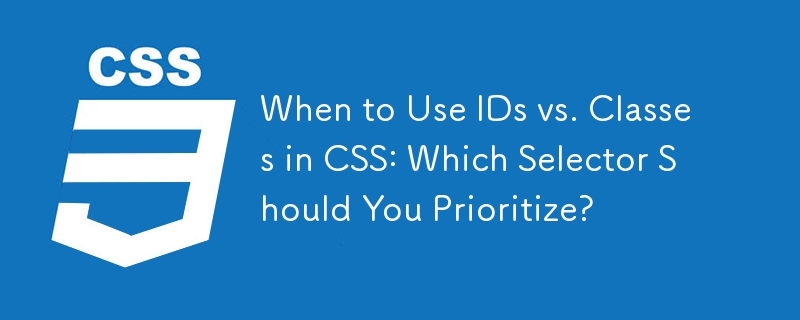 Web Front-end
Web Front-end
 CSS Tutorial
CSS Tutorial
 When to Use IDs vs. Classes in CSS: Which Selector Should You Prioritize?
When to Use IDs vs. Classes in CSS: Which Selector Should You Prioritize?
When to Use IDs vs. Classes in CSS: Which Selector Should You Prioritize?

ID vs. Class Selectors in CSS
The question of which selector, ID or class, to prioritize in CSS has sparked discussions among web developers. This article aims to provide insights and best practices to guide your decision-making.
ID Selectors: Specificity and Scope
IDs uniquely identify an element within a document. They are highly specific and ensure that a style will only be applied to that particular element. However, IDs should be used sparingly as they can hinder code maintainability and limit the flexibility of styles.
Class Selectors: Versatility and Reusability
Classes, on the other hand, can be applied to multiple elements. This versatility allows for a more efficient and scalable approach to styling. They enable designers to reuse styles across multiple elements or create styles that can be toggled on or off dynamically.
Best Practices
- Prioritize Reusability: Use classes for styles that you intend to reuse.
- Preserve Uniqueness: Limit the use of IDs for styling unique elements, such as headers or special elements.
- Consider Future Needs: If there's a possibility of future elements requiring the same styles, choose a class over an ID.
- Avoid Overspecificity: Overly specific selectors with multiple class or ID combinations can make code difficult to maintain.
- Follow Consistency: Establish a consistent naming convention for your selectors to improve code readability.
Additional Considerations
- Efficiency: IDs are more efficient than classes when styling a single element.
- Page Changes: Using IDs for frequently changing elements may result in unwanted styling conflicts.
- Responsive Design: Classes provide greater flexibility for responsive design as they allow for dynamic styling based on viewport size.
Ultimately, the choice between ID and class selectors depends on the specific design requirements. By adhering to the best practices outlined above, you can optimize your CSS for maintainability and flexibility.
The above is the detailed content of When to Use IDs vs. Classes in CSS: Which Selector Should You Prioritize?. For more information, please follow other related articles on the PHP Chinese website!

Hot AI Tools

Undresser.AI Undress
AI-powered app for creating realistic nude photos

AI Clothes Remover
Online AI tool for removing clothes from photos.

Undress AI Tool
Undress images for free

Clothoff.io
AI clothes remover

Video Face Swap
Swap faces in any video effortlessly with our completely free AI face swap tool!

Hot Article

Hot Tools

Notepad++7.3.1
Easy-to-use and free code editor

SublimeText3 Chinese version
Chinese version, very easy to use

Zend Studio 13.0.1
Powerful PHP integrated development environment

Dreamweaver CS6
Visual web development tools

SublimeText3 Mac version
God-level code editing software (SublimeText3)

Hot Topics
 1664
1664
 14
14
 1422
1422
 52
52
 1316
1316
 25
25
 1268
1268
 29
29
 1241
1241
 24
24
 Google Fonts Variable Fonts
Apr 09, 2025 am 10:42 AM
Google Fonts Variable Fonts
Apr 09, 2025 am 10:42 AM
I see Google Fonts rolled out a new design (Tweet). Compared to the last big redesign, this feels much more iterative. I can barely tell the difference
 How to Create an Animated Countdown Timer With HTML, CSS and JavaScript
Apr 11, 2025 am 11:29 AM
How to Create an Animated Countdown Timer With HTML, CSS and JavaScript
Apr 11, 2025 am 11:29 AM
Have you ever needed a countdown timer on a project? For something like that, it might be natural to reach for a plugin, but it’s actually a lot more
 HTML Data Attributes Guide
Apr 11, 2025 am 11:50 AM
HTML Data Attributes Guide
Apr 11, 2025 am 11:50 AM
Everything you ever wanted to know about data attributes in HTML, CSS, and JavaScript.
 A Proof of Concept for Making Sass Faster
Apr 16, 2025 am 10:38 AM
A Proof of Concept for Making Sass Faster
Apr 16, 2025 am 10:38 AM
At the start of a new project, Sass compilation happens in the blink of an eye. This feels great, especially when it’s paired with Browsersync, which reloads
 How We Created a Static Site That Generates Tartan Patterns in SVG
Apr 09, 2025 am 11:29 AM
How We Created a Static Site That Generates Tartan Patterns in SVG
Apr 09, 2025 am 11:29 AM
Tartan is a patterned cloth that’s typically associated with Scotland, particularly their fashionable kilts. On tartanify.com, we gathered over 5,000 tartan
 How to Build Vue Components in a WordPress Theme
Apr 11, 2025 am 11:03 AM
How to Build Vue Components in a WordPress Theme
Apr 11, 2025 am 11:03 AM
The inline-template directive allows us to build rich Vue components as a progressive enhancement over existing WordPress markup.
 While You Weren't Looking, CSS Gradients Got Better
Apr 11, 2025 am 09:16 AM
While You Weren't Looking, CSS Gradients Got Better
Apr 11, 2025 am 09:16 AM
One thing that caught my eye on the list of features for Lea Verou's conic-gradient() polyfill was the last item:
 A Comparison of Static Form Providers
Apr 16, 2025 am 11:20 AM
A Comparison of Static Form Providers
Apr 16, 2025 am 11:20 AM
Let’s attempt to coin a term here: "Static Form Provider." You bring your HTML



